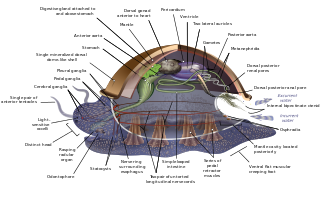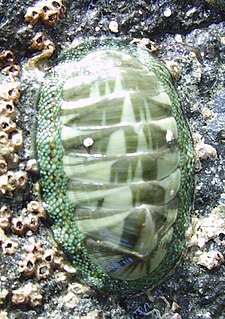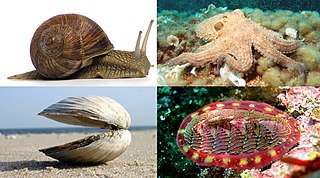
The atom probe was introduced at the 14th Field Emission Symposium in 1967 by Erwin Wilhelm Müller and J. A. Panitz. It combined a field ion microscope with a mass spectrometer having a single particle detection capability and, for the first time, an instrument could “... determine the nature of one single atom seen on a metal surface and selected from neighboring atoms at the discretion of the observer”.
The radula is an anatomical structure used by mollusks for feeding, sometimes compared to a tongue. It is a minutely toothed, chitinous ribbon, which is typically used for scraping or cutting food before the food enters the esophagus. The radula is unique to the molluscs, and is found in every class of mollusc except the bivalves, which instead use cilia, waving filaments that bring minute organisms to the mouth.

Chitons are marine molluscs of varying size in the class Polyplacophora, formerly known as Amphineura. About 940 extant and 430 fossil species are recognized.

Limpets are a group of aquatic snails that exhibit a conical shell shape (patelliform) and a strong, muscular foot. Limpets are members of the class Gastropoda, but are polyphyletic, meaning the various groups called "limpets" descended independently from different ancestral gastropods. This general category of conical shell is known as "patelliform" (dish-shaped). All members of the large and ancient marine clade Patellogastropoda are limpets. Within that clade, the members of the Patellidae family in particular are often referred to as "true limpets".

The gumboot chiton, also known as the giant western fiery chiton or giant Pacific chiton, is the largest of the chitons, growing to 36 cm (14 in) and capable of reaching a weight of more than 2 kg (4.4 lb). It is found along the shores of the northern Pacific Ocean from Central California to Alaska, across the Aleutian Islands to the Kamchatka Peninsula and south to Japan. It inhabits the lower intertidal and subtidal zones of rocky coastlines. The gumboot chiton's appearance has led some tidepoolers to refer to it, fondly, as the "wandering meatloaf". The name "gumboot chiton" seems to derive from a resemblance to part of a rubber Wellington boot or "gum rubber" boot.

The evolution of the molluscs is the way in which the Mollusca, one of the largest groups of invertebrate animals, evolved. This phylum includes gastropods, bivalves, scaphopods, cephalopods, and several other groups. The fossil record of mollusks is relatively complete, and they are well represented in most fossil-bearing marine strata. Very early organisms which have dubiously been compared to molluscs include Kimberella and Odontogriphus.

Chiton glaucus, common name the green chiton or the blue green chiton, is a species of chiton, a marine polyplacophoran mollusk in the family Chitonidae, the typical chitons. It is the most common chiton species in New Zealand. Chiton glaucus is part of a very primitive group of mollusc with evidence of being present in up to 80 million years of the fossil record.

Mollusca is the second-largest phylum of invertebrate animals after the Arthropoda. The members are known as molluscs or mollusks. Around 85,000 extant species of molluscs are recognized. The number of fossil species is estimated between 60,000 and 100,000 additional species. The proportion of undescribed species is very high. Many taxa remain poorly studied.

The Drilliidae are a taxonomic family of small predatory sea snails with high-spired shells. They are classified as marine gastropod mollusks in the superfamily Conoidea.

A tooth is a hard, calcified structure found in the jaws of many vertebrates and used to break down food. Some animals, particularly carnivores and omnivores, also use teeth to help with capturing or wounding prey, tearing food, for defensive purposes, to intimidate other animals often including their own, or to carry prey or their young. The roots of teeth are covered by gums. Teeth are not made of bone, but rather of multiple tissues of varying density and hardness that originate from the embryonic germ layer, the ectoderm.

Chaetopleura is a genus of chitons in the family Chaetopleuridae. The species within this genus are marine molluscs.

The hairy chiton is a species of chiton in the family Chaetopleuridae. It is a marine mollusc.
Chaetopleura pertusa, the orange hairy chiton, is a species of chitons in the family Chaetopleuridae. It is a marine mollusc. It is endemic to South Africa.

Nipponacmea is a genus of sea snails, the true limpets, marine gastropod mollusks in the family Lottiidae.
Mopalia ciliata is a chiton in the genus Mopalia, commonly known as the hairy chiton. It is a medium-sized marine mollusc up to 5.0 cm in length. It is oval shaped with 8 separate moderately elevated, overlapping ridged valves on its dorsal surface. It resides along the coast of North America.

Plaxiphora tricolor is a species of chiton in the family Mopaliidae.

Turridae is a taxonomic family name for a number of predatory sea snails, marine gastropod mollusks in the superfamily Conoidea.

Acanthochitona crinita is a species of marine chiton in the family Acanthochitonidae. It is found on rocky coasts in the northeastern Atlantic Ocean, the North Sea and the Mediterranean Sea.














